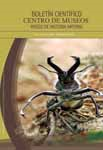Authors
Abstract
Between January, 2006 and July, 2008, we studied the temporal variation in the number of plants with ripe fleshy fruit in a remnant tropical humid forest (Bh-T) in the mountainous region Serranía de las Quinchas, in the Colombian Magdalena Medio. We traveled across the forest during 122 weeks crossing a 8,294 m. length transect. We registered the presence of fruit on this transect, we identified the parental plants, their perpendicular distance from the center of the transect and their direction; at the same time we recorded the daily rainfall. We calculated the number of fruiting plants in terms of density every other week and we carried out a regression between density and rainfall. In this study we registered 773 individuals belonging to 145 species and 37 families which correspond to 85% and 89% representativeness. The months with higher quantities of fruiting plants were March, April and December while January, June and October presented lower quantities; this variation was determined in a 6% because of the rainfall periods. This study allowed us to highlight 15 key species for the sustainability of the frugivorous community in the area, since such species show productivity peaks distributed in time and together produce fruits all year long. These results can be used to design Bh-T conservation and restoration plans.
References
BASCOMPTE, J. & JORDANO, P., 2008. Redes mutualistas de especies. Investigación y ciencia, 384: 50-59.
CASADO-BERNABELA, R., 2009. Consumidores de frutos y su relevancia en la dispersión y germinación de semillas del cactus globoso Melocactus schatzlii. Tesis de Maestría, Universidad de Los Andes, Facultad de Ciencias, Mérida, Venezuela.
CASTAÑO, J.H., 2009. Murciélagos frugívoros y plantas quiropterocoras: descubriendo la estructura de sus interacciones mutualistas en una selva semicaducifolia. Tesis de Maestría, Universidad de Los Andes, Facultad de Ciencias, Mérida, Venezuela.
CHAPMAN, C.A.; CHAPMAN, L.J.; WRANGHAM, R.; HUNT, K.; GEBO, D. & GARDNER, L., 1992. Estimators of fruit abundance of tropical trees. Biotropica, 24 (4): 527-531.
CHAPMAN, C.A. & WRANGHAM, R., 1994. Indices of habitat-wide fruit abundance in tropical forests. Biotrópica, 26 (2): 160-171.
COLWELL, R.K., 2005. EstimateS: statistical estimation of species richness and shared from samples. University of Connecticut, USA.
COLWELL, R.K. & CODDINGTON, J.A., 1994. Estimating terrestrial biodiversity through extrapolation. Phil. Trans. R. Soc. Lond. B., 345 (1311): 101-118.
DI CASTRI, F. & HAJEK, E.R., 1976. Bioclimatología de Chile. Universidad Católica de Chile.
ETTER, A., 1998. Bosque húmedo tropical: 106-133 (en) CHAVES, M.E. & ARANGO, N. (eds.) Informe nacional sobre el estado de la diversidad. Instituto de Investigación de Recursos Biológicos Alexander von Humboldt, PNUMA, Ministerio del Medio Ambiente. Bogotá, Colombia.
FLEMING, T.H.; BREITWISH, R. & WHITESIDES G.H., 1987. Patterns of tropical vertebrate frugivore diversity. Ann. Rev. Ecol. Syst., 18: 91-109.
GUERRERO, J., 2007. Descripción de algunos aspectos de la ecología y composición social de un grupo de Ateles hybridus (i. Geoffroyi-St. Hilaire, 1829) en la Serranía de las Quinchas, Colombia. Tesis, Pontificia universidad javeriana, Facultad de Estudios Ambientales y Rurales, Bogotá, Colombia.
HEMINGWAY, C.A. & OVERDORFF, D.J., 1999. Sampling effects on food availability estimates: Pheological method, simple size and species composition. Biotrópica, 31 (2): 354-364.
HERNÁNDEZ-CAMACHO, J.; ORTIZ, R.; WALSHBURGER, T. & HURTADO, A., 1992. Estado de la biodiversidad en Colombia: 41-225 (en) HALFFTER, G. (ed.) Diversidad biológica de Iberoamérica I. Instituto de Ecología, A.C. México.
JARAMILLO, R.A., 2005. El clima andino y café en Colombia. Cenicafé.
JIMÉNEZ-VALVERDE, A. & HORTAL, J., 2003. Las curvas de acumulación de especies y la necesidad de evaluar la calidad de los inventarios biológicos. Revista Ibérica de Aracnología, 8: 151-161.
JORDANO, P., 2000. Fruits and frugivory: 125-166 (en) FENNER, M. (ed.) Seeds: the ecology of regeneration in plant communities. CABI Publ., Wallingford, UK.
LAVERDE, O.R.; STILES, F.G. & MÚNERA, C., 2005. Nuevos registros e inventario de la avifauna de la Serranía de las Quinchas, un área importante para la conservación de las aves (aica) en Colombia. Caldasia, 27 (2): 247-265.
MOLINARI, J., 1993. El mutualismo entre frugívoros y plantas en las selvas tropicales: Aspectos paleobiológicos, autoecológicos, papel comunitario. Acta Biológica, Venezuela, 14 (4): 1-44.
MORALES, J.A., 2007. Ecología alimentaria de tres especies de saltarines (Aves: Pipirdae) en una plantación forestal mixta de los Andes centrales colombianos. Tesis, Universidad de Caldas, Facultad de Ciencias Exactas y Naturales, Manizales.
ROLDÁN, A. & LARREA, D., 2003. Fenología de 14 especies arbóreas y zoócoras de un bosque yungueño en Bolivia. Ecología en Bolivia, 38 (2) :125-140.
SORIANO, P.; SOSA, M. & RUSELL, O., 1991. Hábitos alimentarios de Glossophaga longirostris Miller (Chiroptera: Phyllostomidae) en una zona árida de los Andes Venezolanos. Rev. Biol. Trop., 39 (2): 263-268.
STEVENSON, P., 2004. Phenological patterns of woody vegetation at Tinigua park, Colombia: Methodological comparisons with emphasis on fruit production. Caldasia, 26 (1): 125-150.
THOMAS, L.; BUCKLAND, S.T.; BURNHAM, K.P.; ANDERSON, D.R.; LAAKE, JL.; BORCHERS, D.L. & STRINDBERG, S., 2002. Distance sampling: 544-552 (en) EL-SHAARAWI, A.H. & PIEGORSCH, W.W. Encyclopedia of Environmetrics. Vol 1. John Wiley & Sons, Ltd, Chichester.
THOMAS, L.; LAAKE, J.L.; STRINDBERG, S.; MARQUES, F.F.C.; BUCKLAND, S.T.; BORCHERS, D.L.; ANDERSON, D.R.; BURNHAM, K.P.; HEDLEY, S.L.; POLLARD, J.H.; BISHOP, J.R.B. & MARQUES, T.A., 2006. Distance 5.0. Research Unit for Wildlife Population Assessment, University of St. Andrews, UK. En: http://www.ruwpa.st-and.ac.uk/distance/
VÍLCHEZ, B., CHAZDON, R. & REDONDO, A., 2004. Fenología reproductiva de cinco especies forestales del Bosque Secundario Tropical. Kurú: Revista Forestal (Costa Rica), 1 (2): 1-10.
VILLARREAL, H.; ÁLVAREZ, M.; CÓRDOBA, S.; ESCOBAR, F.; FAGUA, G.; GAST, F.; MENDOZA, H.; OSPINA, M. & UMAÑA, A.M., 2006. Métodos para el análisis de datos: una aplicación para resultados provenientes de caracterizaciones de biodiversidad: 185-226 (en) Manual de métodos para el desarrollo de inventarios de biodiversidad. Instituto de Investigación de Recursos Biológicos Alexander von Humboldt, Bogotá. Colombia.
WALLACE, R.B. & PAINTER, R.L.E., 2002. Phenological patterns in suothern Amazonian tropical forest: implications for sustainable management. Forest Ecology and Management, 160: 19-33.
WILLIAMS-LINERA, G. & MEAVE, J., 2002. Patrones fenológicos: 407-431(en) GUARIGUATA, M. & KATTAN, G. (eds.) Ecología y conservación de bosques neotropicales. Ediciones LUR, Costa Rica.

 PDF (Español)
PDF (Español)
 FLIP
FLIP


















